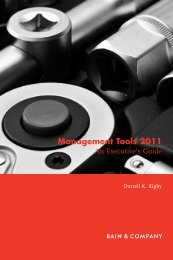Service now! Time to wake up the sleeping giant - Bain & Company
Service now! Time to wake up the sleeping giant - Bain & Company
Service now! Time to wake up the sleeping giant - Bain & Company
You also want an ePaper? Increase the reach of your titles
YUMPU automatically turns print PDFs into web optimized ePapers that Google loves.
Spotlight: managing maintenance contracts<br />
Many industrial companies understand that maintenance<br />
contracts are an attractive way <strong>to</strong> secure<br />
stable service revenues while providing <strong>the</strong> cus<strong>to</strong>mer<br />
with improved equipment performance. But <strong>the</strong>ir<br />
maintenance contract growth strategies often fail <strong>to</strong><br />
deliver on <strong>the</strong>ir expected volume and margin targets.<br />
Even worse, in some instances, badly designed service<br />
contracts even incur substantial losses cemented<br />
by long-term contracts that are hard <strong>to</strong> exit. In<br />
our daily work we have identified a combination of<br />
typical mistakes that can turn a promising opportunity<br />
in<strong>to</strong> a deficit maker:<br />
• The offerings in <strong>the</strong> contract are <strong>to</strong>o broad,<br />
going beyond <strong>the</strong> competencies of <strong>the</strong> OEM’s<br />
service field force<br />
• Tools are not in place <strong>to</strong> properly precalculate<br />
delivery cost and facilitate adequate contract<br />
pricing<br />
• Pricing doesn’t reflect <strong>the</strong> operational risks<br />
assumed in <strong>the</strong> contract<br />
• The field force is not ready for <strong>the</strong> volume of<br />
contracts sold due <strong>to</strong> resource and capability<br />
gaps<br />
• Sales capabilities are insufficient for selling <strong>to</strong><br />
<strong>the</strong> cus<strong>to</strong>mer <strong>the</strong> additional value generated by<br />
service contracts, resulting in low margins<br />
These pitfalls can be avoided. Successful selling follows<br />
a clear business development path and requires<br />
a salesforce that is closely attuned <strong>to</strong> <strong>the</strong> specific<br />
needs and opportunities of <strong>the</strong> market and cus<strong>to</strong>mer<br />
segments (see Figure 8).<br />
• Identify attractive segments for service contracts,<br />
e.g., by analyzing equipment usage patterns and<br />
inhouse capabilities<br />
• Develop segment-specific value propositions that<br />
create economic or operational benefits, such<br />
as operating cost savings, quality improvements,<br />
higher <strong>up</strong>time<br />
• Design smart contracts with standardized modules<br />
<strong>to</strong> reduce complexity, exclude bulk risks and<br />
define clear exit clauses<br />
• Set <strong>up</strong> a value pricing system linked <strong>to</strong> <strong>the</strong><br />
cus<strong>to</strong>mer’s operational benefits and including<br />
regular price increases, e.g., by establishing a<br />
link <strong>to</strong> labor and material cost indexes<br />
• Build a systematic sales process s<strong>up</strong>ported by<br />
strong sales arguments and sales s<strong>up</strong>port <strong>to</strong>ols,<br />
target relevant equipment systematically,<br />
combine contracts with new equipment sales<br />
• Structure sales processes <strong>to</strong> drive efficiency by increasing<br />
regional portfolio density <strong>to</strong> shorten<br />
travel time<br />
• Make costs and profitability visible by developing<br />
relevant key performance indica<strong>to</strong>rs (KPIs) and<br />
management dashboards<br />
It is also important <strong>to</strong> recognize that maintenance<br />
contracts are not viable in all situations. There are<br />
clear indica<strong>to</strong>rs <strong>to</strong> show where potential is low, such<br />
as cus<strong>to</strong>mers regarding maintenance as one of <strong>the</strong>ir<br />
core competencies, failure of <strong>the</strong> OEM <strong>to</strong> achieve<br />
scale advantages or excessive operational risks that<br />
cannot be properly controlled by <strong>the</strong> service provider.<br />
22 <strong>Service</strong> <strong>now</strong>! <strong>Time</strong> <strong>to</strong> <strong>wake</strong> <strong>up</strong> <strong>the</strong> <strong>sleeping</strong> <strong>giant</strong>
















